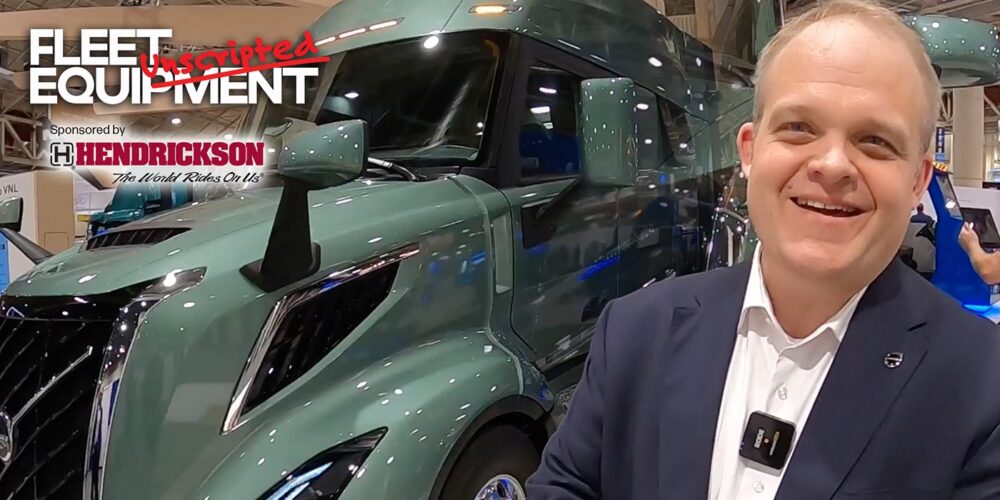Fleet Equipment was on-site for an in-depth exploration of Stoneridge’s vision and safety product offerings for the commercial vehicle market, specifically its MirrorEye technology. In the manufacturing plant’s parking lot, a Freightliner Cascadia was parked, distinguished from others by a notable absence: traditional mirrors. Instead, advanced cameras with screens mounted on the A-pillars inside the cab provide drivers a comprehensive view of their surroundings.
Mario Gafencu, responsible for fleet operations, testing and validation with Stoneridge, offered a system rundown.
“It’s a camera monitoring system to replace truck mirrors. The idea is simple: provide side views for the driver using high-definition digital cameras on the outside and high-definition digital displays on the inside. However, it’s a complex system,” he said.
Installed above the doors, the cameras grant drivers enhanced visibility through wide-angle and standard views. The system is also equipped with right-side lookdown and rear view lenses designed to eradicate blind spots, particularly on the passenger side, which can lead to near misses or collisions.
“We have five cameras on the outside and three monitors inside for the MirrorEye system. The driver’s side monitor provides the regular view with a wide-angle view at the bottom, mirroring the functionality of a traditional glass mirror,” Gafencu explained. “The passenger side monitor provides identical views. We also have a third monitor for the look-down camera mounted at the bottom on the passenger side.”
Watching the episode, viewers will notice that each side wing is equipped with two cameras. However, both are not active simultaneously. One serves as a backup, activating only if its counterpart encounters technical difficulties.
“If anything happens to the first camera, the system switches to the secondary camera. It will display identical images to the driver since they’re mounted side by side,” Gafencu added.
A hydrophobic layer coats the camera lens, repelling dust, water and dirt. To cater to those in colder regions, the system is heated to prevent ice and snow from blocking the camera’s view.
For nighttime driving, the combination of infrared lights, filters, and high-definition vision ensures the system offers sharp, accurate imagery even after sunset. Compatible with all cab configurations of the Freightliner Cascadia, Peterbilt Model 579, Kenworth T680, Volvo VNLs, and VNRs from 2019 onward, this system brings numerous benefits beyond improved visibility.
“Doing away with mirrors immediately enhances visibility,” Gafencu said. “It also reduces the driver’s stress, fatigue, and anxiety. Moving around for eight to 10 hours a day isn’t typical. The need to constantly check mirrors places a strain on the driver.”
Describing the challenges, he added, “It’s like drivers are doing aerobics. They frequently adjust their positions to get a better view around the mirror, especially when making turns.”
Enhanced visibility isn’t the only perk. While deciding to retain or discard side mirrors during this technology’s implementation is up to the customer, Gafencu mentioned that removing them could result in a 2-3% fuel efficiency increase due to better aerodynamics and reduced drag.
Initially, spending a few weeks with both the camera system and mirrors helps drivers acclimate, Gafencu advised.
Although Stoneridge isn’t responsible for physically removing mirrors, the Federal Motor Carrier Safety Administration (FMCSA) approved the camera monitoring system as an alternative to traditional mirrors in December 2018, as it meets or surpasses all visibility criteria.
Gafencu elaborated, “When customers first get the system, we suggest letting drivers familiarize themselves for two to four weeks. Transitioning from a basic glass mirror to a sophisticated digital system requires some adjustment.”
The cameras record continuously when active. This data, stored in the truck, is easily accessible via a web portal if safety managers need to review it. The footage can clarify incidents or serve as a training tool for drivers. So what happens to all of that data?
“We have an open API. We’re collaborating with major dashcam companies. When they highlight a video, they can retrieve it from the truck in the same way a safety manager would,” Gafencu said. “We can integrate our systems, allowing safety managers to retrieve videos without navigating multiple portals.”
Fleet Equipment’s On The Road is sponsored by Wix Filters. Subscribe to our newsletter to catch every episode as we dive into the best practices and servicing information to keep your trucks On The Road.













